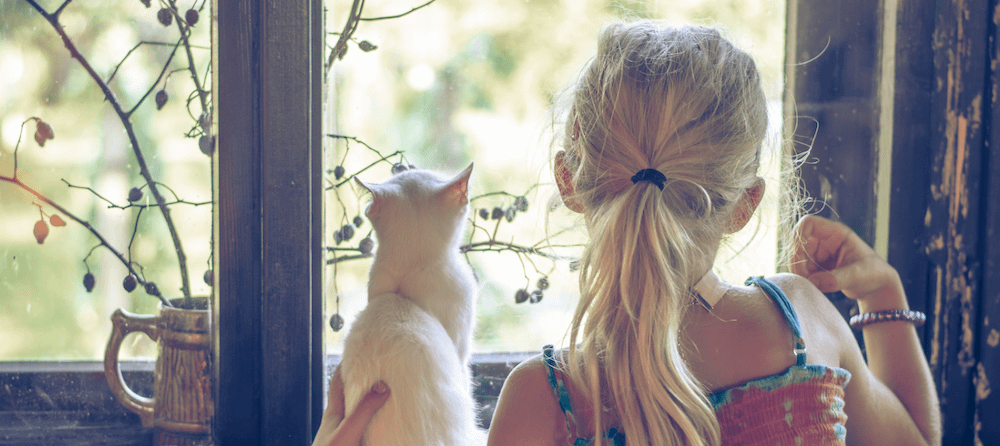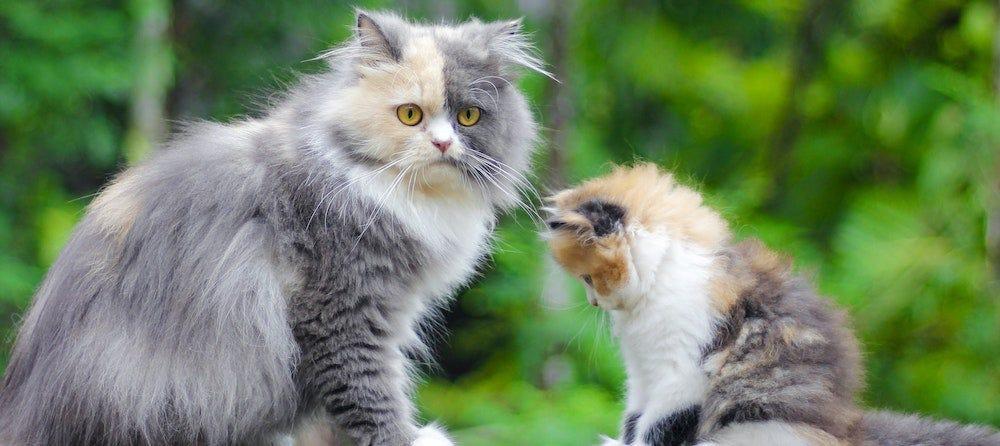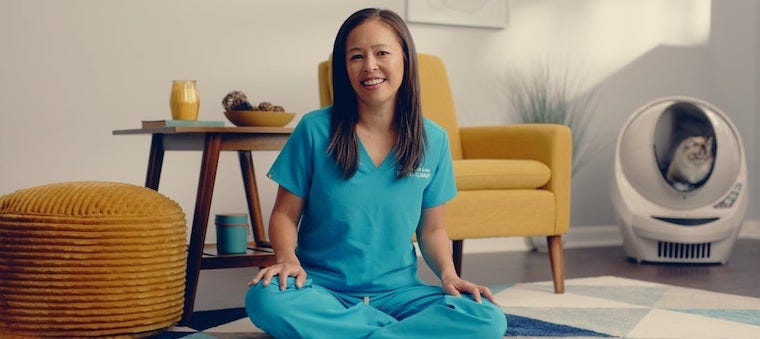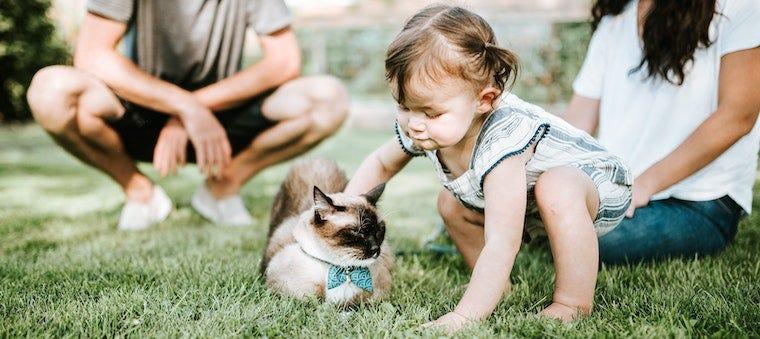You’ve probably heard that 1 dog year is equivalent to 7 human years, but is the formula really that simple? The conversion formula for both dog and cat years to human years is actually much more complex. Since both of these animals mature at a faster rate than humans, the first years of your pet’s life actually equate to more human years than the subsequent years. You also need to account for the months when calculating the human age for a younger cat, like a 6-month-old kitten, for example.
To get a better idea of how cat and human ages equate, use our cat age calculator:
How to calculate your cat’s age
When calculating dog age, you have to factor in different sizes and breeds. It’s simpler with cats, considering most cats range from 7 to 15 pounds, excluding obese kitties. The gap is much smaller than that of dog breeds.
The first two years of aging goes much faster than the rest of your cat’s years with the following calculations:
- First year: Your cat will age about 15 human years.
- Second year: Your cat ages an additional 9 human years.
- Third year and on: Your cat ages approximately 4 human years per year afterward.
How old is my cat in human years? A table
To get a better understanding of what “human” age your indoor cat might be, take a look at the following cat years to human years table.
| Cat years | Human years |
|---|---|
| 1 month | 1.5 |
| 3 months | 4.5 |
| 6 months | 9 |
| 9 months | 12 |
| 1 | 15 |
| 2 | 24 |
| 3 | 28 |
| 4 | 32 |
| 5 | 36 |
| 6 | 40 |
| 7 | 44 |
| 8 | 48 |
| 9 | 52 |
| 10 | 56 |
| 11 | 60 |
| 12 | 64 |
| 13 | 68 |
| 14 | 72 |
| 15 | 76 |
| 16 | 80 |
| 17 | 84 |
| 18 | 88 |
An alternative formula
Tracie Hotchner, the author of “The Cat Bible,” offers a slightly different variation on the aforementioned cat age calculator. In this alternative formula, Hotchner delves more specifically into the corresponding ages of young kittens to similarly young human children.
Here, courtesy of Hotchner, is the answer to the question, “How old is a cat in human years?”
- A 1-month-old kitten is equivalent to a 6-month-old human baby
- A 3-month-old kitten is equivalent to a 4-year-old child
- A 6-month-old kitten is equivalent to 10 human years
- An 8-month-old kitten is equivalent to a 15-year-old human
- A 1-year-old cat has reached adulthood, the equivalent of 18 human years
- A 2-year-old cat is equivalent to a 24-year-old human
- A 4-year-old cat is equivalent to a 35-year-old human
- A 6-year-old cat is equivalent to a 42-year-old human
- An 8-year-old cat is equivalent to a 50-year-old human
- A 10-year-old cat is equivalent to a 60-year-old human
- A 12-year-old cat is equivalent to a 70-year-old human
- A 14-year-old cat is equivalent to an 80-year-old human
- A 16-year-old cat is equivalent to an 84-year-old human
How do cats age?
Based on a variety of factors, cats may age at different paces, no different than time affecting humans differently as they age. Typically, the way that the calculations are adjusted is by matching cat ailments to ailments humans experience as they age.
This is why a 1-year-old cat is similar to a 15-year-old human—their development stage is about the same. And why by 18 years, a cat acts similarly to and may have similar conditions as an 88-year-old human.
Why do cats mature early?
Your feline companion is your precious baby, we know, but you must remember that cats are still animals. They are much closer to their wild roots than we bipedal humans.
A primary example of this is the way that humans have evolved to have long gestation periods and then even longer periods of intensive rearing and childcare. Domesticated house cats have a gestation period of only 66 days and give birth to kittens that require just a small portion of the kind of attention and care that human babies require.
If you’re having trouble grasping early maturation in cats, look at it this way: Kittens do most of their growing in the first 6 months of life. In fact, healthy kittens grow 8 times their size in just about 8 weeks! By approximately 1 year old, cats will weigh at or around their adult weight. Adult cats typically range from 7 to 15 pounds, depending on the breed.
How do you know when your cat has stopped growing? Most veterinarians agree that your cat is done growing between 9 months and 2 years old. However, some cat breeds take years to fully mature. Learn more about cat life stages from the American Animal Hospital Association (AAHA).
What factors influence aging in cats?
While all breeds of cats typically age at the same pace, some factors might make a cat age faster than others. All cats are different, and their health, environment, and diet can play a role in their aging process.
Environment
Where a cat grows up can heavily influence how old they appear to be. Cats that have experienced trauma may appear to be more weathered and not as youthful. Trauma ages animals, but that doesn’t always mean their spirit and energy will match what they’ve gone through! Sometimes a bit of TLC is all your cat needs to get them acting like a kitten again.
Diet and nutrition
Cats that aren’t on appropriate diets may have more ailments. Having balanced nutrition can make the aging process feel slower, as your cat will maintain their health and activity levels. It’s important to monitor their eating habits and make sure they are consuming a nutritious diet. Cat food comes in both wet and dry versions—wet food is more hydrating.
Cat health-related issues
Cats diagnosed with certain diseases and ailments might age faster than other cats. Cats that experience health-related issues may appear to be older than they actually are.
The indoor vs. outdoor factor
If you used our cat years to human years calculator above, you might be wondering why you had to specify whether your cat is indoor-only, outdoor-only, or a mix. The sad fact is, a cat’s environment largely influences their lifespan. Ask a veterinarian, and they’ll tell you: Cats that go outside are more at risk of harm or injury.
Just as ancient man lived outdoors and had a life expectancy of 20 to 30 years, outdoor cats face exposure, predators, harsh conditions, and chronic “wear and tear” that can ultimately lead to a shorter life expectancy. Indoor cats are the modern equivalent of pampered, sheltered royalty when compared to outdoor cats or even indoor/outdoor cats.
Speaking of indoor/outdoor cats: Even if 90-95% of your cat’s life is indoors, your veterinarian still needs to know about the small percentage of time spent outdoors.
Why? Because it affects how they care for your cat and what diagnostics, vaccines, medications, and treatments they may use.
Why do outdoor cats “age” faster?
So, why is a 5-year-old indoor cat in the prime of his life (36 years old in human years) while a 5-year-old outdoor cat has already entered middle age (48 years in human years)?
There’s a difference between an outdoor cat with no home (i.e., feral or stray) and a cat with a loving home that just happens to live outside. The former’s lifespan is adversely affected by a lack of vaccinations and routine vet visits, as well as not being spayed or neutered. But even if your outdoor cat is vaccinated, sees the vet regularly, and is spayed or neutered, there are still a lot of risks that come with living outside.
First, being outside poses trauma dangers. Your cat might get hit by a car, attacked by a dog or coyote, injured by the neighborhood bully, or beaten up by the neighborhood tomcat. Veterinarians report trauma as the number one issue seen in a veterinary ER with indoor/outdoor cats.
Trauma can result in fractures, lung bruises, internal bleeding, and even death. And if you’re lucky enough to save a kitty’s life, treatment may cost several thousands of dollars plus rehabilitation and recovery. Treatment doesn’t always end after the initial emergency visit. Follow-up visits are often required to ensure that recovery is going as expected.
Next, being outside poses poisoning dangers. Something as simple as your cat eating your neighbor’s tiger lilies or daylilies, digging around and finding some mouse poison, or accidentally being exposed to antifreeze in your neighbor’s driveway can result in significant organ damage, failure, or untimely death.
Finally, the outdoors poses infection or disease transmission risks that can potentially be fatal to your cat. Fighting with other cats can easily result in your cat getting the blood infection feline leukemia (FeLV) or kitty AIDS/FIV. (Learn more about FeLV and FIV at Cornell Feline Health Center.)
If your cat goes outside, the risks of worms, fleas, ticks, and other parasites dramatically increase. It’s extremely important that your outdoor cat be vaccinated and up-to-date on their FeLV and rabies vaccines, along with year-round flea, tick, and heartworm medication.
What are the signs of aging in cats?
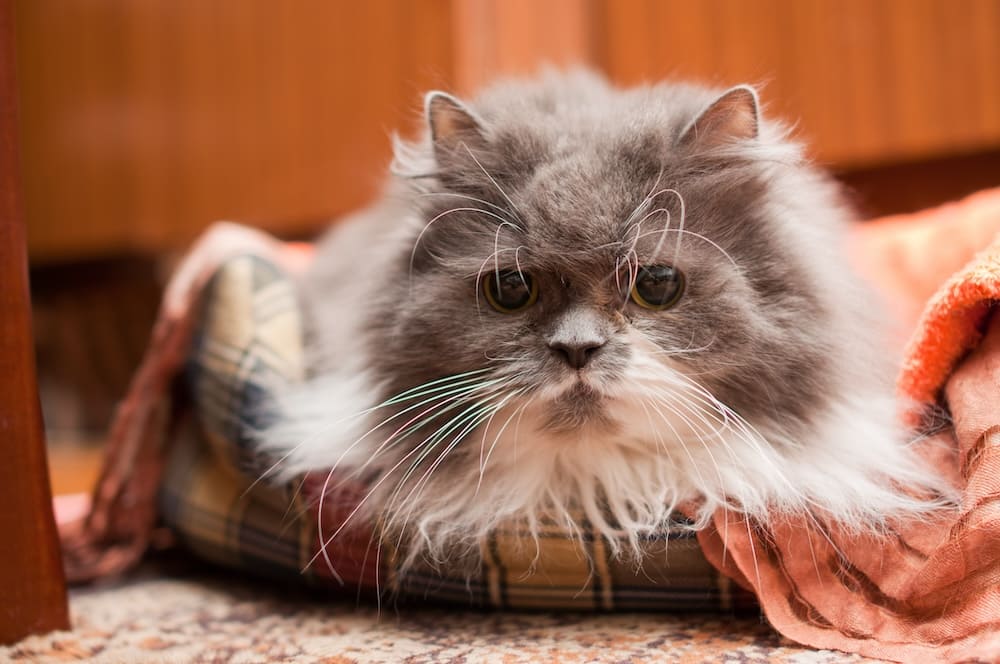
If you adopted your cat, you might not know their exact age. However, knowing the age of your feline friend is an essential part of cat care.
Here are some characteristics to look for to help you estimate your cat's age:
- Cat’s fur: Kittens and young cats usually have soft and smooth coats, whereas older cats might have thicker, coarser coats. You might even notice some grey in an older cat's fur.
- Cat’s teeth: Kittens usually don’t get all their teeth until they’re about 6 months old, and younger cats tend to have much whiter teeth. Some senior cats have missing teeth, and tartar build-up can be common. Cat dental care is vital.
- Cat’s eyes: Young cats may have brighter eyes, and older cats’ eyes could start showing cloudiness around age 12 (but this is not always the case).
- Cat’s hormonal changes: As early as 5 months of age, an unspayed female kitten might start going into heat. Signs include territorial marking, mating calls, or wanting to escape outdoors.
- Cat’s mobility and activity levels: Older cats tend to move less and be less playful than younger cats. Less activity can also contribute to more weight gain and decreased muscle mass in older cats.
Learn more about how to tell how old your cat is.
Ways to look at cat age vs. human age
Though the common perspective on cat years and human years is trying to figure out how old our cats are in human years, that conversion can be applied both ways.
That is to say, if you consider the maximum human life to be 100 years, then, based on the Cat Calculator, the maximum age of a cat is 20.8 years. On the other side of the coin, if you consider that, as “The Cat Bible” suggests, 16 human years is comparable to 84 cat years, then a 100-year-old human could be said to be the equivalent of 525 cat years.
Though this is a generally less practical way to consider the relative aging rate, it does serve as an important reminder… The way we experience time, the length of our human years, and the meaning we assign to certain-numbered years (the big 3-0, for example) is a matter of perspective. Some other oft-quoted ideas come to mind: “It’s not the years in your life, but the life in your years” and “You’re only as old as you feel.”
How old is your cat according to the cat years to human years formula? Or perhaps we should ask, how old are YOU in cat years?
Making the best of your cat’s life
The goal of having a pet is to give them the best life possible so they can be healthy and happy in your home for years to come. We want to spend as much time with our pets as they want to spend with us, and there are ways to set up your cat for success.
We want the space that our cat lives in to be up to their standards, so having plenty of toys, cat furniture, scratching posts, treats, soft beds and blankets, and lots of love is essential.
Ensuring there’s a clean and tidy litter box is part of caring for a cat. A self-cleaning litter box can promote a better sense of trust between you and your feline friend, allowing them to relax because they always have a clean place to go to the bathroom.
Taking your cat to regularly scheduled veterinarian appointments can also increase the amount of time that you have together. As long as they are being cared for and getting all of the vaccinations and check-ups that they need, they will feel safe with you. Their quality of life goes up when you make it easy for them to live their best life!
Sources:
- 2021 AAHA/AAFP Feline Life Stage Guidelines | American Animal Hospital Association
- Aging in Cats: Owner Observations and Clinical Finding in 206 Mature Cats at Enrolment to the Cat Prospective Aging and Welfare Study | NCBI
- Indoors or Outdoors? An International Exploration of Owner Demographics and Decision Making Associated with Lifestyle of Pet Cats | NCBI
- Cornell Feline Health Center | Cornell University College of Veterinary Medicine
- Uncontrolled Outdoor Access for Cats: An Assessment of Risks and Benefits | PMC
- Dental Cleaning in Cats | VCA
